
Guests
- Chris Moyeenvironmental governance campaigner for Global Witness and author of their new report “Peru’s Deadly Environment.”
The United Nations Climate Conference is being held in Peru, which is now the world’s fourth most dangerous country for environmental defenders. Four were killed in September alone. In a brutal incident in a remote region of Peru’s Amazon rainforest, leading indigenous activist Edwin Chota was ambushed as he traveled to neighboring Brazil for a meeting on how to address the region’s illegal logging crisis. Illegal loggers allegedly killed and dismembered Chota along with his colleagues Jorge Ríos, Francisco Pinedo and Leoncio Quinticima. Chota is among at least 57 environmental activists who have been assassinated in Peru since 2002. The Peruvian government has recently passed legislation that rolls back forest protections, which has increased the pace of such murders. We are joined by Chris Moye, the environmental governance campaigner for Global Witness and author of their new report, “Peru’s Deadly Environment.”
Transcript
AMY GOODMAN: We’re broadcasting from Lima, Peru, where the United Nations Climate Change Conference is underway. The protests against the summit on Wednesday fell on International Human Rights Day, which seems fitting, because Peru is now the fourth most dangerous country for environmental defenders, with four killed in September alone. In a brutal incident in a remote region of Peru’s Amazon rainforest, a leading indigenous activist named Edwin Chota was ambushed as he traveled to neighboring Brazil for a meeting on how to address the region’s illegal logging crisis. It was those same illegal loggers who allegedly killed and dismembered Chota along with his colleagues, Jorge Ríos, Francisco Pinedo and Leoncio Quinticima. This is Edwin Chota speaking about how his life had been repeatedly threatened.
EDWIN CHOTA: [translated] There are good business people, but there are others who are only evil, who threaten to kill. We are threatened, but we welcome death. Why? For the defense of our nature, our life and our children’s future. The law has not yet come to us. We do not feel the law, and our villagers are threatened, threatened because we do not take this.
AMY GOODMAN: In fact, that was Edwin Chota. We’re going to turn right now to Chris Moye, the environmental governance campaigner for Global Witness. He’s here at the climate conference, author of a new report called “Peru’s Deadly Environment.” I asked him to lay out his findings.
CHRIS MOYE: As you rightly pointed out, Peru is the second most dangerous country in Latin America and the fourth most dangerous country in the world to be an environmental land defender, with 57 killings over—between 2002 and 2014. And when we looked at the sectors that are most responsible for those killings, there are two. That’s the extractive sector and the forest sector. The extractive sector saw 80 percent of all of those killings, with 40 cases over the decade. And the forest sector saw five high-profile killings in the last two years of anti-illegal logging activists.
And there are two primary causes for it now, the immediate causes of those killings and the underlying governance problems that our report looks at, right? In terms of the immediate causes, we’re seeing 73 percent of those cases over the last decade were at the hands of state security forces. And this has a long history in Peru going back to Fujimori and even beyond. And in terms of the underlying causes, you’re seeing weakening environmental legislation in the extractive sector. You’re seeing a failure to properly implement free, prior and informed consent for indigenous communities. And in the forest sector, you’re seeing, you know, massive rates of illegal logging, ranging from 80 to 90 percent of total logging. And also you’re seeing huge problems in terms of monitoring the flow of illegal timber and, finally, of land, titling land—pending land title applications for indigenous communities that mainly reside in the Amazonian forest sector.
AMY GOODMAN: I wanted to turn back to Edwin Chota. While Democracy Now! was here in Lima, I spoke with Edwin Chota’s widow, Julia Pérez, as well as with Ergilia Rengifo, the widow of Jorge Ríos, about the work their husbands were doing before they were killed, which they are now carrying on. In this clip, Julia Pérez, Chota’s widow, begins by describing her husband’s murder, as she cradles her infant son Edwin Chota Jr. in her arms.
AMY GOODMAN: Your husband’s remains have been found? How did Edwin Chota and the other men die?
JULIA PÉREZ: [translated] What happened was, when Edwin and the others were walking, they were walking towards Brazil through the forest. And there were a group of them, and a few of them had gone ahead, further ahead, and had walked faster and were waiting at some point and got tired of waiting and turned around to find out, you know, what was taking the other guys so long.
And they returned back on the path, and they found the bones and the remains—no longer the bodies, but just the bones—of Edwin Chota and Jorge Ríos and the other two. And that’s when they returned to the village, and that’s when we found out that Edwin Chota and our husbands were no longer. And they came back to the community and told us then, and they told me, and we told Ergilia and other widows of the leaders who were killed.
ERGILIA RENGIFO LÓPEZ: [translated] I demand justice. That’s what I ask, even though they don’t take much notice. We’ve been struggling for years, and this saddens me. Let the culprits find out what it’s like to suffer. That person should be found dead, detained and put in prison. Their families should suffer as we are suffering, because the truth is, they get off easy. They’re happy with their families, who they cherish. But for four of us, no father will be around to cuddle with their children. For example, I have my baby, who’s five months old. What father will cherish my son? Who will give him tender, loving care? Instead, they get to go free, because I’ve heard that they—they have more rights than us. How can that be?
AMY GOODMAN: That’s Ergilia Regifo, who is the widow of Jorge Ríos, and before that, Edwin Chota’s widow, Julia Pérez, both holding their infants, their husbands killed in the last months. Chris Moye, as you document this, it is believed they were killed by illegal loggers, who have not been held accountable yet. But that’s not the majority of the Peruvian Earth defenders that have been killed. And then let’s go broader, to the world.
CHRIS MOYE: Sure. I mean, at the global level, in April we published a report, “Deadly Environment,” that documented 908 killings of environmental land defenders, but primarily—50 percent of those happened, though, in Latin America, so it’s clear that Latin America is a very dangerous continent, Peru being the second most dangerous country.
AMY GOODMAN: And what does rolling back environmental regulation have to do with the killings of these environmentalists?
CHRIS MOYE: Sure. So, for example, in Peru, there’s a very high-profile case that happened in 2009 called the Bagua case. And that related to indigenous communities protesting against numerous laws that the Alan García government of the time was trying to pass, trying to roll back environmental legislation—namely, weakening the environmental impact assessment process, weakening the ability of the Ministry of Environment to assign protected areas, leading indigenous communities to protest against the fact that they were not consulted about these laws, because these laws directly affect them, as they live in the areas where these extractive-sector projects are likely to take place, and, you know, they live in protected areas.
Edwin Chota’s case is emblematic of a wider forest-sector problem, which is that Edwin had been fighting for a decade to title his communities a forested area. And there are over 20 million hectares of pending land titles from indigenous communities, all of whom reside in the Amazon region in the forest areas. If you want to best protect those forests, you assign those land titles to them.
AMY GOODMAN: An Ecuadorean Shuar indigenous leader who opposed a major mining project was found dead just days before he was due to speak here in Lima. José Isidro Tendetza Antún had opposed the Mirador open-pit copper and gold mine, which would devastate swaths of the southern Amazon. Well, on Monday, I had a chance to speak with Narcisa Aucay. She was a neighbor of José Isidro Tendetza Antún, and I met her at a panel of women Earth activists. And she described what happened to her neighbor, the slain activist, who they were waiting for to speak here in Lima. She is translated by Amazon Watch’s Atossa Soltani.
NARCISA AUCAY: [translated] We were surprised, because then I had to leave for Quito to come to Lima. And then, when I got there, I started to hear that he had died and that they had—the police had basically buried him without the permission of his family. And that seems really weird that we didn’t know that he was dead. No one had notified anyone in the community that he had passed, and that later we come to Quito and we find out that he had already been buried.
No one really knows why he was killed, and their reason has to be investigated. But what we know is that he was tortured. His arms were broken. His hands were tied. They had tied his arms and—broken his arms and then tied them in the back and then thrown him in the river.
AMY GOODMAN: Does his death make you afraid?
NARCISA AUCAY: [translated] From the news reports, from the information I’ve received from Domingo Ankuash, the Shuar leader, his arms were broken, and he was tied up, and he was killed in this brutal way, tortured. Of course that makes me scared. I know when the god calls me, I’m going to die, but I don’t want to die like that. And of course this scares me.
AMY GOODMAN: That is Narcisa Aucay, a neighbor of José Isidro Tendetza Antún, at a panel of women environmentalists here in Lima. We just bumped into her afterwards. Now, Chris Moye, this is in neighboring Ecuador. Can you talk about what this threat means, as she was describing the message these killings are having?
CHRIS MOYE: Sure. Well, in the Amazonian region over the last two or three years, you know, you’re seeing a rise in the killings of indigenous activists fighting against their forests being handed over to the extractive sector or to the logging industry. And that particular case is quite emblematic of also another interesting phenomenon, which is that you’re seeing greater investment by Chinese companies and Chinese banks, etc., in the region, in extractive-sector projects and infrastructure projects that affect forested areas, as, you know, Canadian companies and as American companies and European companies sell their companies to the Chinese companies, because they unsuccessfully tried to extract those resources or to have some kind of problem there. So that case is emblematic of these wider killings. And these wider killings have happened over the last two, three years and have intensified.
AMY GOODMAN: I want to turn to Wilfredo Saavedra Marreros, president of the Environmental Defense Front of Cajamarca in the Andes of northern Peru. Through mass protest, residents of the region have successfully stalled plans by the U.S. firm Newmont to destroy mountain lakes in order to construct the massive, open-pit Conga gold mine. In 2012, the struggle made national headlines when police waged a crackdown, killing five people. Peruvian President Ollanta Humala has backed the Conga mine project. Saavedra and fellow environmental defenders have traveled across Peru to denounce the project in Lima. On Monday, they marched through the streets to demand protection of their water, and Saavedra talked about repression they faced on their journey.
WILFREDO SAAVEDRA MARREROS: [translated] We have made an effort, even though they have criminalized our social protest, even though the police have tried to prevent us from arriving in Lima. They have seized our cars. There’s been constant police harassment of a lot of our marching brigades, because we have come from town to town making use of our own resources, making community meals to feed ourselves, from the 3rd of December until this morning, when we arrived here in Lima. And despite all of that, they have not been able to break our unity and our fierce will to come here to Lima to express ourselves.
AMY GOODMAN: That was Wilfredo Saavedra Marreros, president of the Environmental Defense Front of Cajamarca in the Peruvian Andes. Chris?
CHRIS MOYE: Yeah, and that’s really indicative of a problem that Peru has had over the last decade, in terms of state security forces killing environmental and land defenders. And interestingly enough, the Humala government recently passed a law, 30151, which grants immunity from prosecution for state security forces as they carry out their duties, in the case that they should use violence against, say, peaceful protesters. So, the primary agents of the killings of environmental land defenders in Peru are now being given carte blanche to essentially, you know, crack down and use as much violence as they want, and they will not be prosecuted. And furthermore, in the decade that preceded the passage of this law, not one single individual policeman or army official was taken to court and prosecuted for the killings of these defenders, so that it’s really an outrage. And civil society has come out strongly against it, including Amnesty International, that has called it a major breach of the right to peaceful assembly.
AMY GOODMAN: You know, that’s very interesting in light of where we’re speaking right now. We’re speaking in Pentagonito, right?
CHRIS MOYE: Mm-hmm.
AMY GOODMAN: This is where the U.N. summit is taking place. Wilfredo Saavedra Marreros, the president of the Environmental Defense Front of Cajamarca, who we just heard, was denouncing this also on the street, that the U.N. climate summit, that is taking place here at Pentagonito, that the COP is a sham, as he marched through the streets of Lima.
WILFREDO SAAVEDRA MARREROS: [translated] COP 20 is nothing more than a kind of deception. It’s a farce. That’s how we perceive it. The representatives of the states of the world are meeting in a place that is stained with blood. In the Pentagonito, that military base, they have extrajudicially executed our brothers. They have burned them. They have disappeared them. Many people, including members of the Andean police, were burned there. And that cannot be anything but a display of the public shame of what Peru is. Ollanta Humala, being the host of the governments of the world, spending millions of dollars, close to $90 million, for this summit, that doesn’t accomplish anything other than lyrical declarations of commitments against the effects of climate change. They have not amounted to anything for 20 years. And today, the people cannot be heard, because they have created security zones, five security zones, where we are not going to be able to get in. We’re not going to be able to get in to express our position, our voice.
AMY GOODMAN: President of the Environmental Defense Front of Cajamarca, denouncing the COP being right here in Pentagonito, which, you know, we see—we’re sort of in the shadow of it—and have learned about where so many were killed and tortured here, Chris.
CHRIS MOYE: Yeah, absolutely. And it paints a kind of murkier image of the progressive image that Peru is trying to portray to the world in terms of its fight against climate change. The progressive image it likes to portray is that, look, we’re going to conserve 75 percent of our forests in an effort to stop deforestation, which, as we know, accounts for 50 percent of all greenhouse gas emissions here in Peru, and we’re also going to reduce to zero net deforestation by 2020. But the reality, as we’ve just heard, is far different. I mean, you’re looking at environmental land defenders being killed, precisely trying to protect the forests against extractive-sector projects. And also, the government of Peru has assigned almost 20 million hectares to the oil industry and to the logging industry in the Amazon. So there’s this kind of contradiction between its progressive image of trying to conserve its forests, but at the same time prioritizing extractive-sector development, which will lead to deforestation and greater greenhouse gas emissions.
AMY GOODMAN: That was Chris Moye of Global Witness. I’m Amy Goodman at the COP 20 here in Lima, Peru.

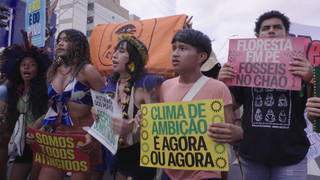
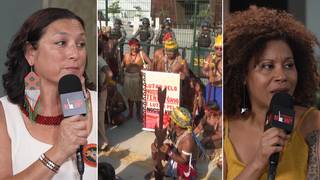
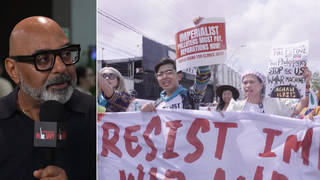
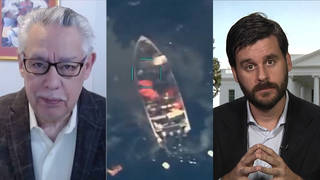





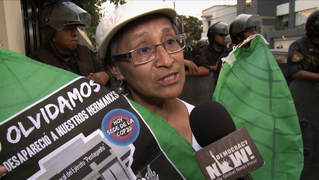
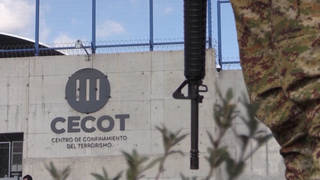
Media Options